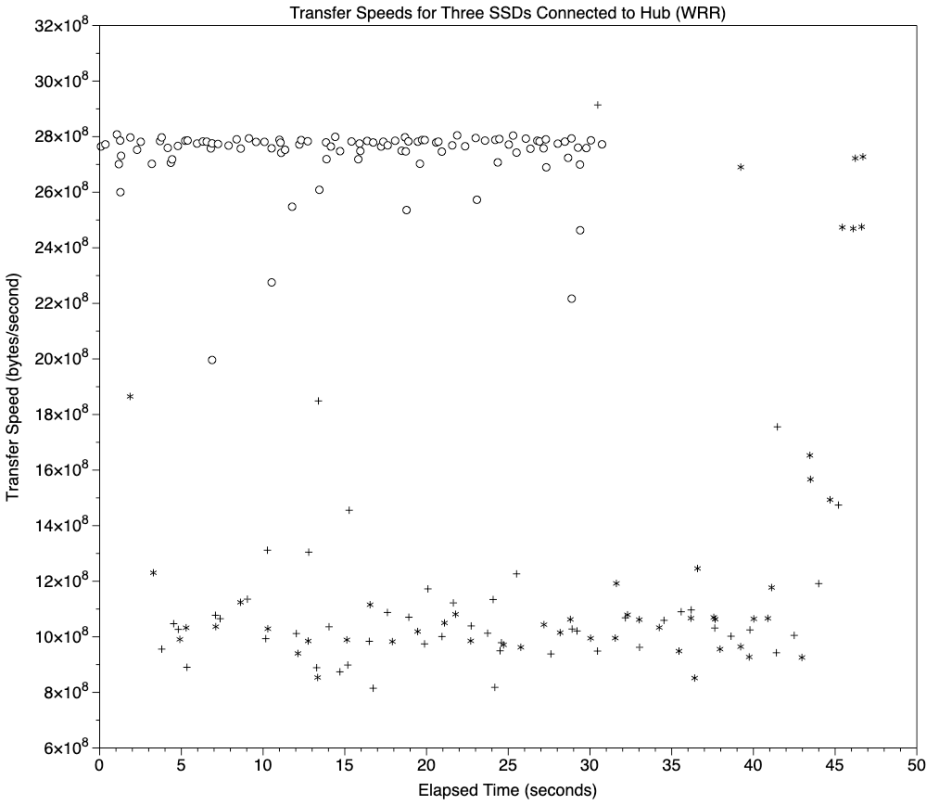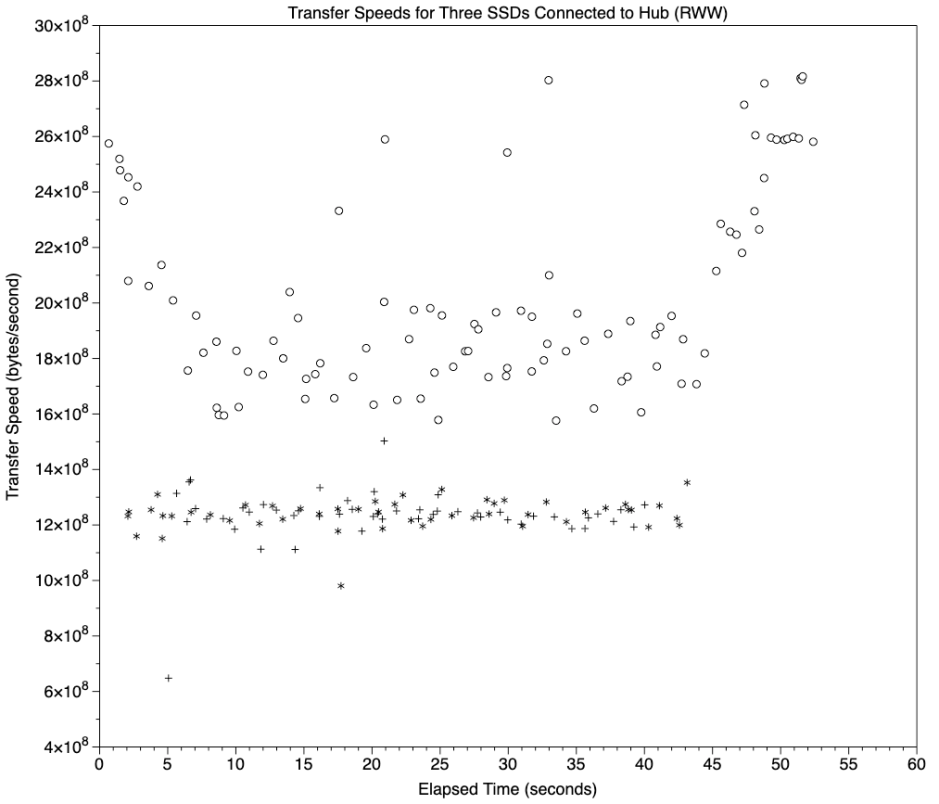You don’t buy a Thunderbolt 4 hub if you aren’t intending to use its three ports to connect SSDs and other peripherals. This article explores the performance of three full-performance SSDs when connected to a hub at the same time. It follows three previous articles:
- the first looked generally at performance using a hub;
- I then looked in more detail at throttling of write speed on some SSDs,
- and focussed on how faster SSDs can impair the performance of slower ones.
Those articles also contain a fuller description of the methods that I’m using.
Methods
For these tests, I’ve used only one of the two Thunderbolt 4 hubs that I’ve got; although models from different suppliers do vary in size and features, they all rely on one Intel chip, the Goshen Ridge controller JHL8440. Because of that, their performance and behaviour in this context should be identical.
I connected all three of my test SSDs to the hub, and ran three separate copies of Stibium to perform speed testing in the following combinations:
- writing to all three SSDs at the same time (WWW);
- reading from all three SSDs at the same time (RRR);
- writing to Disks A and B while reading from Disk C at the same time (RWW);
- reading from Disks A and B while writing to Disk C at the same time (WRR).
Stibium was run in verbose mode, recording each result of the 50 or 100 tests individually. These were then pasted into DataGraph and plotted. In each set of tests I identified the period in which all three SSDs were transferring data, and calculated the total data transferred during that period, deriving overall average transfer speed for that period. Periods ranged from 23-43 seconds, and total data transferred over those periods ranged from 24-92 GB, spread across files of random sizes from 2 MB to 2 GB. Those are far greater than normally used in speed tests of storage.
Simultaneous reads (RRR)
When all three SSDs connected to the hub were reading from it, their speeds were a fairly uniform 1.1-1.2 GB/s, as shown in the chart below. Measurements from Disk C are here shown in circles o, and those from Disks A and B using asterisks * and plus signs + respectively.

The period during which all three SSDs were reading simultaneously started after about 3 seconds had elapsed, and finished at about 47 seconds, when only Disk C was left completing its 100 reads, and returned to reading at about 2.6 GB/s. Total read speed for all three SSDs was 3.4 GB/s, slightly more than the generally accepted maximum for a single Thunderbolt 3 connection.
Simultaneous writes (WWW)
When all three SSDs were writing at the same time, a similar phenomenon occurred as described for two SSDs: write speed was preserved for the fastest of the three SSDs, Disk C (plus signs + here), at 2.1 GB/s, but was throttled on Disks A and B (* and o), as shown in the chart below.

The time interval between the last write to Disk C and Disks A and B returning to a more normal write speed of about 1.4 GB/s was about 10 seconds, which is remarkably long. Total write speed for all three SSDs was 3.4 GB/s, again slightly more than the generally accepted maximum for a single Thunderbolt 3 connection.
Mixed reads and writes (RWW and WRR)
When the fastest SSD, Disk C (o), was writing and Disks A and B (* and +) were reading (WRR), Disk C’s write speed was the same as when it was the only device being used on the hub or connected directly, at 2.8 GB/s. Simultaneous read speeds for Disks A and B were reduced to 1.0 GB/s for a total read of 2.0 GB/s, and a total transfer of 4.8 GB/s.

Once Disk C had completed its high-speed writes, it took over 10 seconds for the read speed of Disks A and B to increase.
With Disk C (o) reading at 1.8 GB/s (RWW), Disks A and B (* and +) wrote more slowly, at 1.2 GB/s, for a total write speed of 2.4 GB/s. Once they had completed, Disk C became faster more quickly, over a period of about 2 seconds.

Total simultaneous transfer was here slightly lower, at 4.3 GB/s.
Overall performance
I have extended the previous table of results to include these triple tests, given as uniform when all reads or writes were performed, and mixed when one SSD was performing a different operation from the other two.

The best and most consistent performance came from Disk C, the only one of the SSDs to retain a write speed in excess of 2.0 GB/s at all times when connected to the hub. However, its read speed fell below 2.0 GB/s when it was sharing more equitably with other SSDs.
Write performance of the other two SSDs fell even lower when all three were writing at the same time, reaching 700 MB/s, performance below that expected for USB 3.1 Gen 2.
We enter murky territory when considering whether Thunderbolt 3 or 4 support simultaneous read and write at full PCIe 3.0 speeds in both directions. Although send and receive lines are separate, Intel appears to state that simultaneous transfer is constrained to a total of 40 Gb/s: “Thunderbolt I/O technology lets you move data between your devices and your computer with 2 channels of 10Gbps flowing both ways (upstream and downstream) at the same time.”
The results above show two situations where that appears to have been exceeded for a period of over 24 seconds for the transfer of tens of GB of data, when SSDs have been reading and writing together. Total transfer rates then were 4.3 and 4.8 GB/s, well above those achievable in one direction alone. This does seem to confirm that, in the right conditions, Thunderbolt 4 is capable of higher speeds with both input and output data at the same time. As far as I’m aware, this is the first time that this has been demonstrated in a regular retail Thunderbolt system, but please correct me if I’m wrong.
Rather than drawing conclusions from these results, tomorrow I’ll provide a guide to achieving best Thunderbolt performance, aimed mainly at Apple silicon Macs, but not completely ignoring Intel models.
